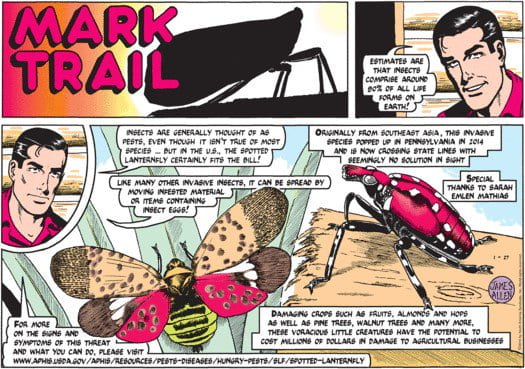Increase awareness and knowledge with something that catches your eye!

NFG, 1/29/19
Increase awareness and knowledge with something that catches your eye!

NFG, 1/29/19
Jan 22, 2019, N F Gregory - The Northeastern IPM Center will host a collection of webinars, titled "Spotted Lanternfly Basics." Each webinar will be tailored to a specific commodity group:

All webinars will follow a similar format that covers spotted lanternfly biology, identification, and hosts, monitoring and management strategies, and a regulatory update. While the content may be relevant to audiences throughout the Northeast, management practices covered will be specific to New York. Participants will be encouraged to ask questions. For more information and registration links, go to: http://neipmc.org/go/mYey
The spotted lanternfly is a non-native plant hopper originally from Asia.

 Lycorma deliculata is small, brightly colored, but very destructive. It was found in Pennsylvania in 2014-15 and has spread slowly, to be found in New Castle County, DE in late 2017. The adult is approx 1 inch by 1/2 inch at rest, and grey/pink in color. Expanded hind wings are a colorful red with black spots and the abdomen yellow. The insect feeds by producing wounds along branches, that exude sap. Hosts include grapes, apples, stone fruits, walnut, willow, and tree of heaven, which officials think is a necessary host for reproduction. Egg masses are laid in November, and look like smears of old chewing gum on branches, rocks, tree trunks, railway boards, cinder blocks, outdoor furniture and vehicles. Eggs will hatch in April or May, and nymphs are red and black. If you find this bug or egg masses, take a picture and contact de.gov/hitchhikerbug More info may be found at: https://dda.delaware.gov/plantind/spotted-lanternfly.shtml .
Lycorma deliculata is small, brightly colored, but very destructive. It was found in Pennsylvania in 2014-15 and has spread slowly, to be found in New Castle County, DE in late 2017. The adult is approx 1 inch by 1/2 inch at rest, and grey/pink in color. Expanded hind wings are a colorful red with black spots and the abdomen yellow. The insect feeds by producing wounds along branches, that exude sap. Hosts include grapes, apples, stone fruits, walnut, willow, and tree of heaven, which officials think is a necessary host for reproduction. Egg masses are laid in November, and look like smears of old chewing gum on branches, rocks, tree trunks, railway boards, cinder blocks, outdoor furniture and vehicles. Eggs will hatch in April or May, and nymphs are red and black. If you find this bug or egg masses, take a picture and contact de.gov/hitchhikerbug More info may be found at: https://dda.delaware.gov/plantind/spotted-lanternfly.shtml .
NFG 12/14/2017